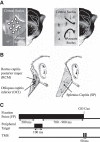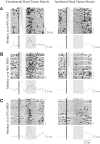Transcranial magnetic stimulation of the prefrontal cortex in awake nonhuman primates evokes a polysynaptic neck muscle response that reflects oculomotor activity at the time of stimulation
- PMID: 25355232
- PMCID: PMC6608421
- DOI: 10.1523/JNEUROSCI.2907-14.2014
Transcranial magnetic stimulation of the prefrontal cortex in awake nonhuman primates evokes a polysynaptic neck muscle response that reflects oculomotor activity at the time of stimulation
Abstract
Transcranial magnetic stimulation (TMS) has emerged as an important technique in cognitive neuroscience, permitting causal inferences about the contribution of a given brain area to behavior. Despite widespread use, exactly how TMS influences neural activity throughout an interconnected network, and how such influences ultimately change behavior, remain unclear. The oculomotor system of nonhuman primates (NHPs) offers a potential animal model to bridge this gap. Here, based on results suggesting that neck muscle activity provides a sensitive indicator of oculomotor activation, we show that single pulses of TMS over the frontal eye fields (FEFs) in awake NHPs evoked rapid (within ∼25 ms) and fairly consistent (∼50-75% of all trials) expression of a contralateral head-turning synergy. This neck muscle response resembled that evoked by subsaccadic electrical microstimulation of the FEF. Systematic variation in TMS location revealed that this response could also be evoked from the dorsolateral prefrontal cortex (dlPFC). Combining TMS with an oculomotor task revealed state dependency, with TMS evoking larger neck muscle responses when the stimulated area was actively engaged. Together, these results advance the suitability of the NHP oculomotor system as an animal model for TMS. The polysynaptic neck muscle response evoked by TMS of the prefrontal cortex is a quantifiable trial-by-trial reflection of oculomotor activation, comparable to the monosynaptic motor-evoked potential evoked by TMS of primary motor cortex. Our results also speak to a role for both the FEF and dlPFC in head orienting, presumably via subcortical connections with the superior colliculus.
Keywords: TMS; animal model; frontal cortex; frontal eye fields; oculomotor system; saccades.
Copyright © 2014 the authors 0270-6474/14/3314803-13$15.00/0.
Figures








Similar articles
-
Neck muscle responses evoked by transcranial magnetic stimulation of the human frontal eye fields.Eur J Neurosci. 2011 Jun;33(11):2155-67. doi: 10.1111/j.1460-9568.2011.07711.x. Eur J Neurosci. 2011. PMID: 21645109
-
Motor output evoked by subsaccadic stimulation of primate frontal eye fields.Proc Natl Acad Sci U S A. 2010 Mar 30;107(13):6070-5. doi: 10.1073/pnas.0911902107. Epub 2010 Mar 15. Proc Natl Acad Sci U S A. 2010. PMID: 20231461 Free PMC article.
-
Transient Pupil Dilation after Subsaccadic Microstimulation of Primate Frontal Eye Fields.J Neurosci. 2016 Mar 30;36(13):3765-76. doi: 10.1523/JNEUROSCI.4264-15.2016. J Neurosci. 2016. PMID: 27030761 Free PMC article.
-
Comparative anatomy of the macaque and the human frontal oculomotor domain.Neurosci Biobehav Rev. 2021 Jul;126:43-56. doi: 10.1016/j.neubiorev.2021.03.013. Epub 2021 Mar 15. Neurosci Biobehav Rev. 2021. PMID: 33737106 Review.
-
Completing the puzzle: Why studies in non-human primates are needed to better understand the effects of non-invasive brain stimulation.Neurosci Biobehav Rev. 2022 Jan;132:1074-1085. doi: 10.1016/j.neubiorev.2021.10.040. Epub 2021 Nov 3. Neurosci Biobehav Rev. 2022. PMID: 34742722 Review.
Cited by
-
Animal Models of Vestibular Evoked Myogenic Potentials: The Past, Present, and Future.Front Neurol. 2018 Jun 25;9:489. doi: 10.3389/fneur.2018.00489. eCollection 2018. Front Neurol. 2018. PMID: 29988517 Free PMC article. Review.
-
Prefrontal Cortex Oxygenation Evoked by Convergence Load Under Conflicting Stimulus-to-Accommodation and Stimulus-to-Vergence Eye-Movements Measured by NIRS.Front Hum Neurosci. 2018 Jul 30;12:298. doi: 10.3389/fnhum.2018.00298. eCollection 2018. Front Hum Neurosci. 2018. PMID: 30104967 Free PMC article.
-
Electrophysiological signatures of veridical head direction in humans.Nat Hum Behav. 2024 Jul;8(7):1334-1350. doi: 10.1038/s41562-024-01872-1. Epub 2024 May 6. Nat Hum Behav. 2024. PMID: 38710766
-
Evidence for a functional subdivision of Premotor Ear-Eye Field (Area 8B).Front Behav Neurosci. 2015 Jan 30;8:454. doi: 10.3389/fnbeh.2014.00454. eCollection 2014. Front Behav Neurosci. 2015. PMID: 25688190 Free PMC article.
-
Neuronal Encoding of Self and Others' Head Rotation in the Macaque Dorsal Prefrontal Cortex.Sci Rep. 2017 Aug 17;7(1):8571. doi: 10.1038/s41598-017-08936-5. Sci Rep. 2017. PMID: 28819117 Free PMC article.
References
-
- Baker SN, Olivier E, Lemon RN. Recording an identified pyramidal volley evoked by transcranial magnetic stimulation in a conscious macaque monkey. Exp Brain Res. 1994;99:529–532. - PubMed
Publication types
MeSH terms
Grants and funding
LinkOut - more resources
Full Text Sources
Other Literature Sources
Miscellaneous
